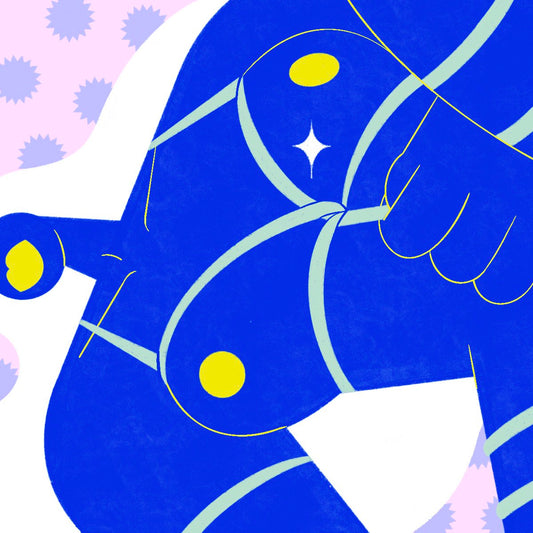Those in the BDSM community often say they understand consent more than most people, because they regularly discuss it. That’s definitely true.
But what’s also true is that a sub often enters a heightened erotic state called the “subspace” – which can easily blur all of the lines. For instance, I know a Dom and his submissive who had agreed that there would be no penetrative sex during their BDSM play. When she had entered a subspace, though, she was so lost in her transcendental state that she wanted to have sex. He had to use their safeword in order to enforce their boundaries and stop the play before it went too far.
As a sex researcher, I’ve rarely seen a deep dive into what subspace actually is, how a person gets there, and how healthy (or unhealthy) it is for a person’s mental well-being. Yet it’s a concept that fascinates me. Ever since I started engaging in and researching kink, the altered state of mind associated with the subspace has fascinated me. On a personal level, it’s a peaceful tranquility that someone like me, who has a near-crippling Type-A personality, rarely gets to experience.
You might be thinking “What the hell is “subspace”? Great, another esoteric term to learn.
” Stick with me, because I promise it’s super-interesting.
Even more importantly, understanding the concept can help everyone appreciate the importance of sexual boundaries – whether they’re full-blown kinksters, they simply indulge in a little light spanking or fetish play every now and then, or they’re only into vanilla sex.
Let's dig more deeply into the whole concept of subspace.
What is subspace?
Subspace is a state of transcendence that many subs enter during BDSM play. Through some combination of sensory deprivation (blindfolds, ball gags, restraints), and pain play (whips, paddles, floggers), the mind may transport a submissive to a different mental plane. It’s sometimes called a “headspace” as well.
Many have described subspace as a trance-like state that’s an out-of-body experience. They say it makes them feel like they’re “floating on a cloud” or “in a state of total peace” – somewhat comparable to reaching orgasm during penetrative or vaginal stimulation. For many who enjoy the role of sub, it’s the primary reason they engage in intense play.
When pre-negotiated pain is being inflicted on a submissive, subspace is often a release from the pain which leaves the sub euphoric.
“Subspace could be defined as the warm, fuzzy, nearly-hypnotic physical and psychological feeling that people experience sometimes when they are in the submissive role,” explains
Pam Shaffer, MFT, a licensed marriage and family therapist. “It is a space of high suggestibility and heightened sensory arousal, which is usually sparked by the adrenaline and endorphins that are released when engaging in BDSM activities.” In intense scenes where pre-negotiated pain is being inflicted on a submissive, subspace is often a release from that pain that leaves the sub euphoric.
Lola Jean, a sex educator and professional dominatrix, points out that not every BDSM session results in subspace, and it isn’t necessary that a sub enters subspace for a BDSM scene to be considered successful. It’s simply an experience – quite enjoyable and satisfying for many submissives – that often results from kinky D/s play.
What causes someone to get into subspace?
In a word, hormones. Intense sex play, even if it’s consensual, may be interpreted by the sympathetic nervous system (which detects pain) as a threat. That signals the brain to activate a fight-or-flight response, causing the body to release
stress hormones like epinephrine and cortisol.
A chain reaction follows. Increased cortisol levels induce the release of more hormones like endorphins and
enkephalins, which are natural chemicals that can boost pain tolerance while increasing the pleasurable, floaty feelings of euphoria. The
parasympathetic nervous system is also activated, creating relaxed and calm feelings in the brain and throughout the body.
When the scene ends, hormones drop. That can cause a subspace to turn into a somewhat-shocking “subdrop,” in which the submissive is not only exhausted but also hot, cold, hungry or even disoriented for a brief time. A caring Dom will provide whatever aftercare is needed, during the several hours after a scene.
Why subs love being in subspace
For many submissives, subspace is the ultimate goal in a BDSM scene. The state of mind can provide such profound release that they feel they’re temporarily leaving all of their troubles behind.
“Mentally, there’s healing that comes from finding this space where your problems melt away and you’re forced to focus on the pleasures and pains your body is experiencing,” says
Daniel Saynt, a sex educator and co-founder of NSFW, a BDSM-focused member’s club. “By incorporating blindfolds or other sensory deprivation tools, subspace can give you a moment to just breathe and calm your mind.”
Shaffer explains that having positive experiences with subspace can help people develop deeper bonds with partners and work through any trust issues they may have. “People who enter subspace and come out the other side can see how they can trust someone else to care for their needs and help keep them safe during an intense situation, as well as developing an appreciation for how resilient they are on their own,” she says.
Can Doms enjoy subspace?
Many do. During a scene, of course, Doms are in charge of what’s happening. During play they may enter their own “topspace,” in which they fully enjoy the power, control and connection with their sub who has entered subspace. It doesn’t provide the same type of euphoria, but can still be extremely pleasurable.
Why boundaries matter when it comes to subspace
As Shaffer points out, subspace puts a submissive into a state of “high suggestibility,” during which they lose full control of their mental function.
That’s precisely the appeal. The possibility of entering subspace sets the stage for Doms to be completely trusted with responsibility for a sub’s well-being. After all, in subspace the submissive may have trouble making informed decisions about issues like penetrative sex or the length of a punishment session.
It’s the Dom’s responsibility to care for the sub in their desired way.
“If you’re planning a BDSM session it’s very important to set your boundaries,” says Saynt. “While in subspace, you may want to ignore these boundaries, so having a respectful partner is important. Have these conversations before sex to ensure consent is always first of mind, even when you’re in subspace.”
And needless to say, it’s even more important to set boundaries
well ahead of time when partners are, for example, having their first in-person encounter after meeting on FetLife, or if play involves a sadistic Dom and/or a submissive who are into masochism.
The difference between subspace and a dissociative mental state
The responsibility a Dom has for their sub goes beyond subspace. Lola Jean tells me that subspace and dissociation can appear similar in the physiological responses they create (closed eyes, non-responsive, dream-like). Dissociation occurs when the body causes the mind to completely black out what’s happening.
Because the two states look similar, it’s critical for Doms and subs to get to know each other, their boundaries, and their reactions to certain stimuli.
“If your submissive becomes non-responsive or displays incoherence in any manner, it is a good idea to halt what you’re doing and begin grounding exercises,” Lola Jean explains. “Ground them by bringing attention back to each of the senses, bringing awareness to touch, sound, smell. Assuming you have taken the time to understand
what type of aftercare they respond best to, you can apply this here as well.”
Both mental states can be disorienting to come down from, so it’s the Dom’s responsibility to care for the sub in the appropriate way. This aftercare should be also discussed in advance.
How subspace can deepen our understanding of consent
While subspace may sound like a totally foreign concept to someone outside of the kink community, it sheds light on the importance of consent in all types of sexual relationships. Both consent and boundaries should be discussed beforehand, not figured out or ignored in the heat of the moment.
It’s not just an issue in BDSM. Even when you’re in a heightened orgasmic state during vanilla sex, you may ask for something or give into an activity that you’ll later regret. Both partners must be respectful of the other’s boundaries. For example, whether someone says, “I don’t want to have intercourse,” or I don’t want to be whipped,” those activities shouldn’t be “pushed” or “suggested” in the heat of a session.
Boundaries are boundaries. We need to learn how to set them, accept them, and respect them.




























